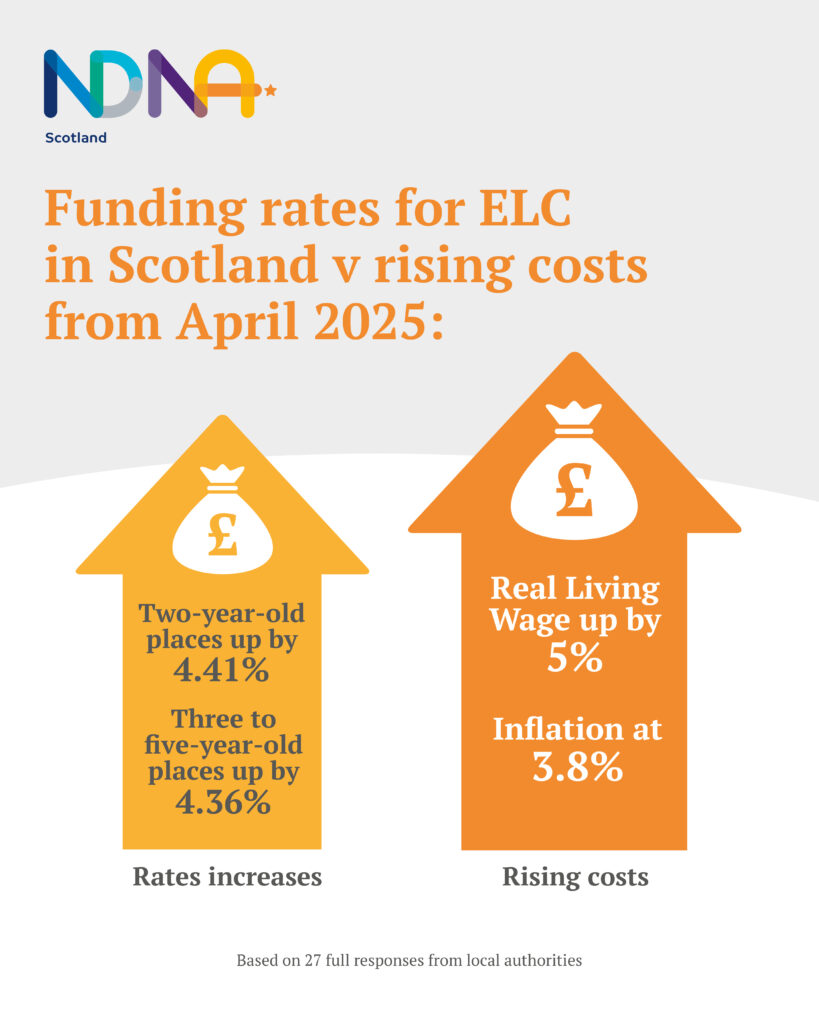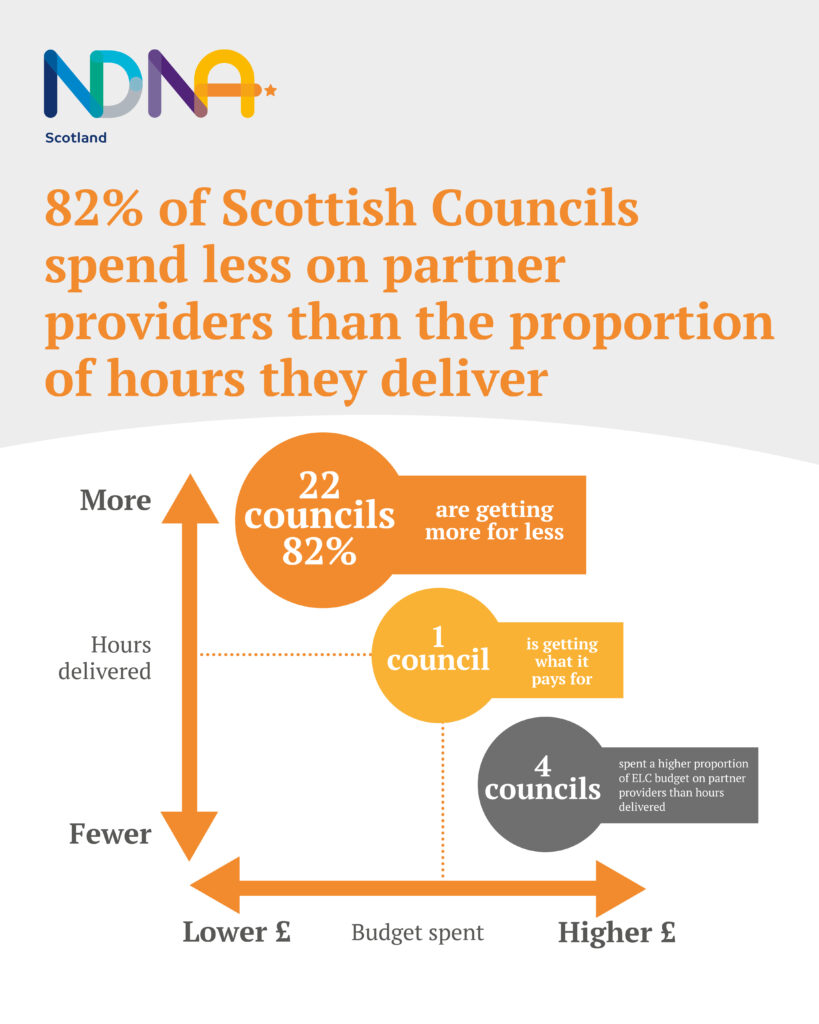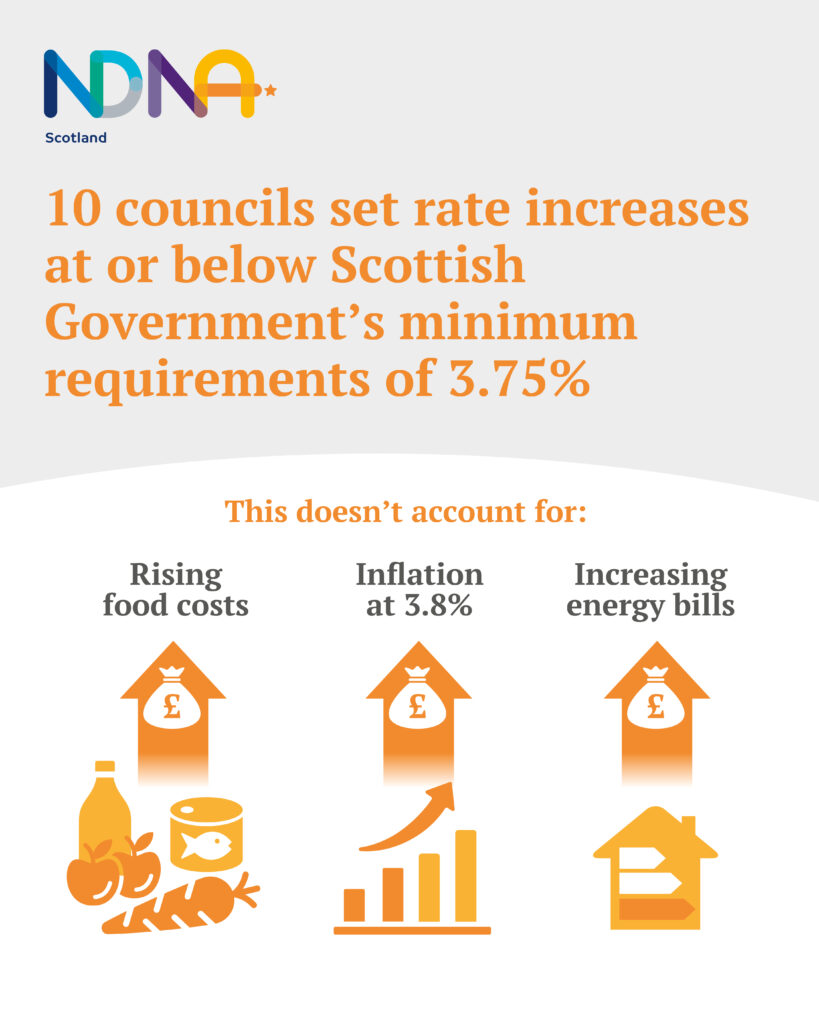
More to do to make childcare funding fairer in Scotland
Two investigations by early years charity National Day Nurseries Association have shown that nurseries and childminders still get a raw deal when delivering funded childcare in Scotland.
Over 80% of councils in Scotland are paying partner providers, including private and voluntary nurseries, a smaller proportion of their Early Learning and Childcare (ELC) budgets compared with the hours of funded ELC they are delivering.
The second investigation showed that a third of councils (33.3%) are failing to follow Scottish Government guidance on setting sustainable rates that increase by more than 3.75% to cover increasing Real Living Wage rates and other rising costs.
The average delivery of funded hours by partner providers, including private and voluntary nurseries and childminders, was 29%. This ranged from 64.8% in Moray to 10.48% in the Shetland Islands.
By contrast an average of 23% of a local authorities’ ELC budgets were allocated to paying partner providers for the hours they delivered. Moray was the highest, giving 54.1% of their budget to partner providers while the Orkney Islands reported a 1.9% spend with partner providers.
Sustainable rates increased by an average of 4.41% for two-year-old places and by 4.37% for three to five-year-old places, with many councils recognising rising staffing costs and operating costs for providers. However, nine out of the 27 councils who responded set rate increases that were at or below the Scottish Government’s minimum uplift of 3.75%.
The three to five-year-old rate has more impact on nursery sustainability because there are many more children on that rate in nurseries than two-year-olds. In 2024, according to government statistics* 6,613 two-year-olds received funded ELC compared with 74,591 three and four-year-olds.
Providers in Edinburgh still do not know the rates which they should have been receiving since April. The City Council responded to say that these will be set in September, which means that providers delivering 40% of the childcare in the city will have been providing funded places for six months before finding out the rates they will receive.

Jonathan Broadbery, NDNA Scotland’s Director of Policy, said: “Our research shows that while the majority of councils in Scotland are improving, there is still a long way to go for partner nurseries to be in a fair position. Councils generally still get a lot more hours from providers compared to the budget they are allocating to this policy.
“Providers have to meet legal requirements on pay and need to cover rising costs in order to stay open. However, not all councils are abiding by funding guidance which sets a minimum uplift just to cover the Real Living Wage increase but highlights that 25% of the rate should account for other inflation.
“With at least a 5% uplift in staffing costs, before you consider the more experienced and skilled staff, and inflation at 3.8% it is unbelievable that a third of councils are not heeding Scottish Government guidance on rate setting.
“Properly- funded ELC leads to high-quality places that boost children’s outcomes, helps tackle child poverty and supports working families. If the funding is not fairly distributed, truly following the child to the settings providing these places, then it risks undermining nurseries’ sustainability and the positive impact this policy can have.”
According to the government guidance on setting sustainable rates: “The minimum uplift only reflects the estimated increase in the average staffing cost element of the sustainable rate required to meet the real Living Wage uplift from April 2025. In addition to the minimum uplifts to cover the estimated additional staffing costs, the final sustainable rate(s) for 2025-26 should also reflect other, non-staffing, cost elements and the requirements for the sustainable rate set out in this guidance.”
NDNA Scotland conducted two data collection exercises from councils in July and August using requests under Freedom of Information (FOI) legislation. The first asked councils for the percentage of 1140 hours which were delivered by partner providers and the percentage of their overall ELC budget used to fund the same providers.
The second asked for their new sustainable rates for 2025/26 to fund places for eligible two-year-olds and three to five-year-olds as well as the percentage uplift of each compared with the previous year’s rate.
The summary of the findings are as follows:
FOI – ELC hours and Budgets
- 30 of 32 councils responded
- One provided a partial response
- Two provided responses which could not be included.
Of the 27 councils who provided full responses which could be compared:
- 4 (14.8% of respondents) councils’ ELC % budget spend was higher than the % hours delivered by partner providers
- 1 council (3.7%) reported equal rates of budget distribution and hours delivered
- 22 (81.5%) councils’ ELC % budget spend was lower than the % hours delivered by partner providers
- On average, 29% of funded ELC in Scottish councils is delivered by partner providers like PVI nurseries and childminders
- On average, Scottish Councils spend 23% of their ELC budgets with partner providers
- There is a 6% gap between the hours delivered by partner providers compared with the budget spent to pay for these.

FOI – ELC hours and Budgets
- 27 of 32 councils responded
- One said they could not respond as rates would not be set until September
- Three had not responded and one council had sought further clarity on the definition of sustainable rates.
Two-year-old rates:
- Average rate is £7.59 p/h
- Average increase from 2024/25 is +4.41%
- 9 councils only increased by 3.75% or less
- East Ayrshire reported a 3.74% increase.
Three to five-year-old rates:
- Average rate is £6.91
- Increase is +4.37%
- 9 councils only increased by 3.75% or less – contravening Scottish Government guidance
- Glasgow reported a 3.72% increase.

- early years
- funding
- Scotland
Similar Articles
Maths Champions: Festive Early Years Maths Success

Above inflation funding rates announced for 2026-27


